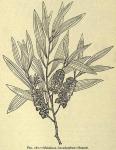 A volatile oil distilled from the leaves of Melaleu'ca leucaden'dron Linné.
A volatile oil distilled from the leaves of Melaleu'ca leucaden'dron Linné.
BOTANICAL CHARACTERISTICS.—A tree with crooked stem and scattered branches, the branchlets drooping like those of the weeping willow; bark whitish. Leaves lanceolate, deep green, entire, from 3 to 4 inches long. Flowers small, white, inodorous, in axillary spikes.
HABITAT.—East Indies.
DESCRIPTION OF DRUG.—A light bluish-green (probably due to copper), limpid liquid having a penetrating, agreeable odor, and a warm, camphoraceous, bitter, afterward saline or cooling, taste. Specific gravity 0.912 to 0.925. It has a slightly acid reaction.
CONSTITUENTS.—The principal constituent is the hydrate of the hydrocarbon, cajuputene, C10H16 (Cajuputol, C10H16H2O), said to be identical with eucalyptol, or cineol, from eucalyptus. The commercial oil often contains a trace of copper, not in large enough quantities to be dangerous, however.
ACTION AND USES.—Highly stimulant, carminative, and a counterirritant in rheumatism. Dose: 1 to 10 drops (0.065 to 0.65 mil).

